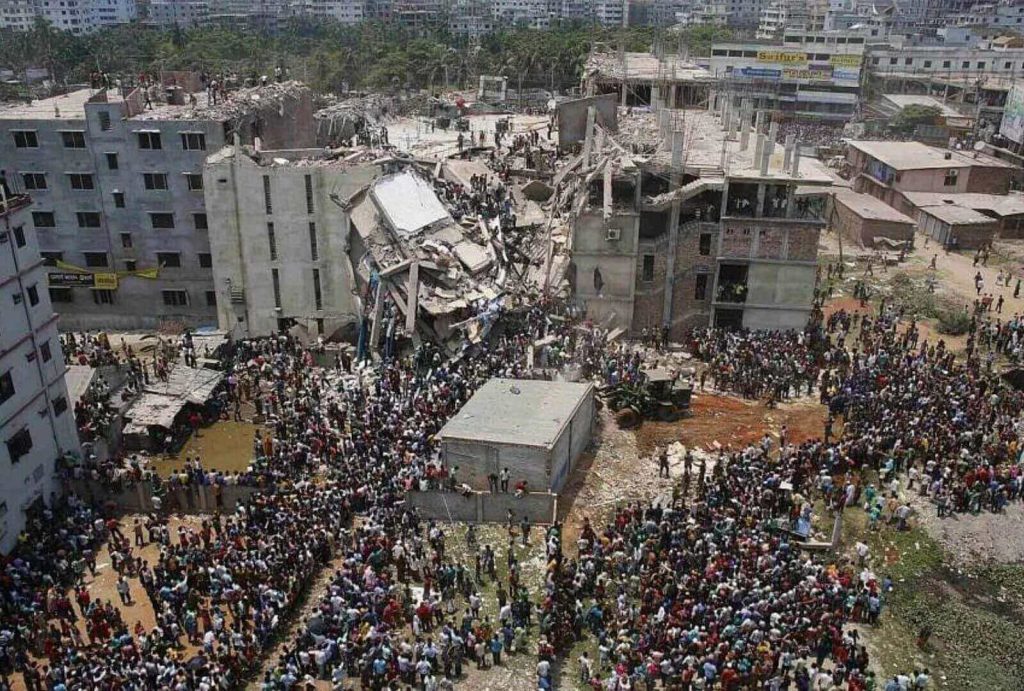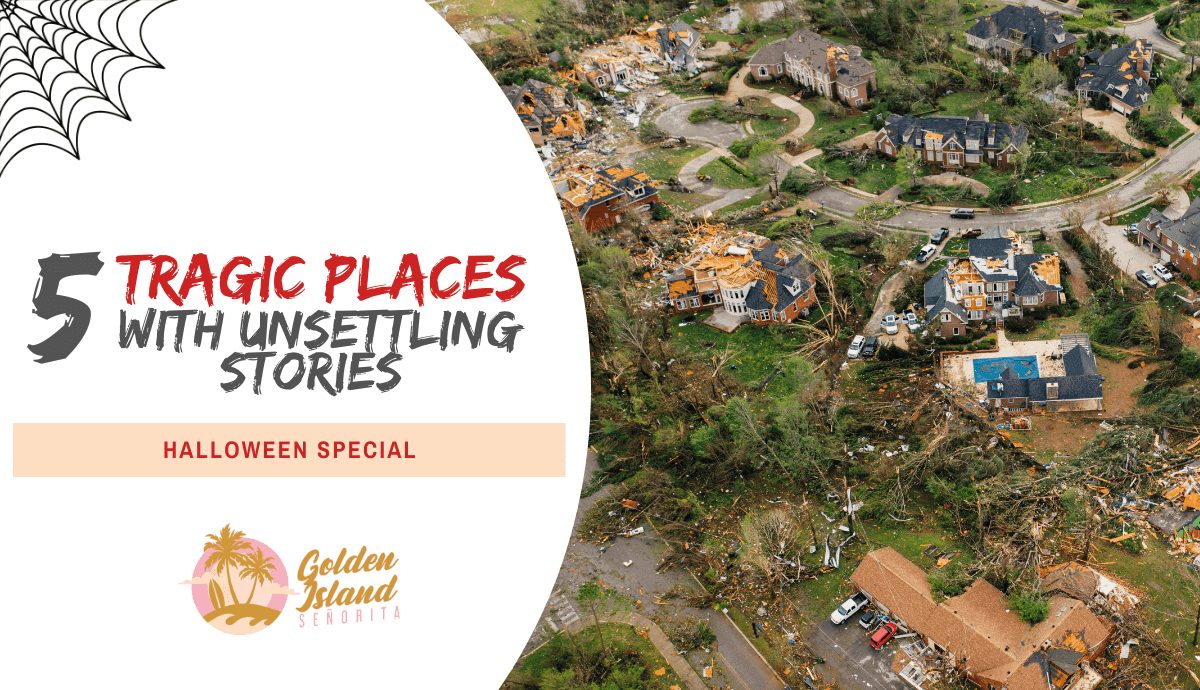Trigger Warning // Accident, Death, Detailed Description Of Accidents, Pictures of the Accidents
Sure, a scary movie, book, or show gets your adrenaline rushing at the moment of consumption—we, like the rest of the planet, covered our eyes in Squid Game. But, for the most part, you may relax knowing that what you’ve watched is a work of fiction designed to frighten you. When the actual world becomes scarier than anything Stephen King could conjure up, you have every right to be afraid of the dark.
In honor of Halloween, I’ve compiled a list of places and the tragic stories that surround them below.
Tragic Place #1: Tsunami Train wreck in Peraliya, Sri Lanka – 2004

On December 26, 2004 with 1,700 fatalities or more, the 2004 tsunami-related train tragedy in Sri Lanka is the worst rail accident in history. It happened when a tsunami that accompanied the 2004 Indian Ocean earthquake wrecked an overcrowded passenger train on a coastal line in Sri Lanka.
STORY: The first of the enormous waves produced by the earthquake was visible on the beach near the village of Peraliya. A warning siren went off to inform the population that the water level had increased as the train came to a stop.
Hundreds of residents, thinking the train was securely fastened to the rails, rushed onto the tops of the cars to prevent being carried away. Others positioned themselves behind the train in the hopes that it would shield them from the force of the water. The initial wave inundated the carriages and made the passengers frantic. A massive wave scooped up the train ten minutes later and slammed it into the houses and trees that surrounded the track, crushing those hiding behind it.
The eight carriages were so crowded with people that the doors would not open when the water filled them; as it continued to pour over the debris, nearly everyone inside drowned. Most of the passengers in the upper deck of the train perished or were crushed by debris after being flung clear of the uprooted carriages.
After traveling 330 feet (100 meters), locomotive #591 Manitoba came to rest in a swamp. The tsunami is estimated to have been between 7.5 and 9 meters (25 to 30 feet) above sea level and 2 to 3 meters (6.6 to 9.8 feet) higher than the top of the train.
Tragic Place #2: Flash Flood in Tinubdan Falls, Cebu – 2021

In the province of Catmon, which is located around 1.5 hours north of Cebu City, Philippines, stands the stunning waterfall known as Tinubdan Falls. Given that most people travel to the south to see well-known waterfalls, it is somewhat of a hidden gem.
STORY: On September 26, 2021, a group of 17 family members went on a weekend getaway to one of Cebu’s most well-known tourist destinations, the Tinubdan falls in Barangay Tabili, Catmon, about 15 kilometers from the city.
The family trip, however, ended up being a horrible nightmare for them when surging floods suddenly came crashing down and engulfed them in a single powerful sweep.
While the others managed to escape the surging waves by clinging to huge boulders and waited for the rescue personnel, three people were reported missing.
Around 1:00 PM, the Tinubdan Falls incident occurred. This was recorded by a drone camera, which was posted on social media last September 26 that has since gone viral.
According to Catmon Police records, 17-year-old Kent Jude Monterola was found sometime around 9:58 PM. Sunday, September 26, about ten hours following the incident. His lifeless body was found in sewage at Sitio Kansija, Barangay Flores, Catmon, 14 kilometers from the location where he and his family were swimming.
Princess Alastra, age 7, was discovered dead on September 27 in Catmon’s Sitio Kulo, Barangay Duyan. While her mother, Jacel Alastra, 32, was found around 1:00 AM on Tuesday, September 28, 2021 in the waters of Barangay Luyang in Carmen, Cebu.
When Kent saw the gush of water, according to witnesses, he returned to save Jacel Alastra and her daughter. He attempted to grab them but was swept away.
According to a witness, it was only drizzling, but the waterfalls’ source seems to be experiencing heavy rain. They heard someone alert them about floods just before it happened. Two minutes after they realized that the nearby water had changed color to brown, it began to rain. They did not expect floods because it was only drizzling at the time.
Since the tragedy, the Tinubdan Falls have been temporarily closed.
Tragic Place #3: Nutty Putty Cave Accident in Utah, USA – 2009

In 2009, an American named John Edward Jones died in the most horrific way possible while exploring the Nutty Putty Cave in Utah. This story is identical to 127 Hours, except that James Franco’s character gets to return home to his family at the end. It’s a disturbing and heartbreaking story about the consequences of venturing into the unknown.
STORY: On November 24, 2009, John Edward Jones, 26, was trapped in the cave for 28 hours, during which time he became stuck and died. Jones had gotten trapped upside-down in a section measuring 10 x 18 inches (25 × 46 cm), around 400 feet (120 m) from the cave’s entrance, after misunderstanding a tiny tunnel with the similarly tight “Birth Canal” passageway when exploring new with his brother.
Jones was immobile like a hook and was unable to move without endangering himself due to the curves in his body. When a pulley broke during the emergency rescue, a large team of rescuers hurried up to help, but they were still unable to get Jones out using a complex rope-and-pulley system.
Jones eventually suffered cardiac arrest as a result of the stress his body endured from being pressed and flipped over for several hours. After rescuers concluded it would be too dangerous to attempt to retrieve Jones’ body, the property owner and Jones’ family agreed that the cave would be completely sealed off with his body within as a memorial to Jones. Jones’ body was close to the ceiling, collapsed using detonators, and the opening hole was filled off with cement to prevent further entry.
John, his wife, and their 13-month-old daughter were traveling to see his family for the holidays. He made the decision to take his family on an exploration of the Nutty Putty Caves because he loves spelunking so much. John entered the cave on November 24th, 2009, along with nine other friends and members of his family. He was studying to become a pediatric cardiologist. He was no amateur; he has been on numerous more complex cave explorations before this one.
Tragic Place #4: Sinkhole Incident in Xining, China – 2020

In northwest China, an enormous sinkhole swallowed up a bus carrying passengers, causing at least six deaths and 16 injuries.
STORY: According to CCTV, the incident happened on January 13, 2020 at approximately 5:30 PM in Xining, the provincial capital of Qinghai, and 16 individuals were brought to the hospital.
A public bus was stopped at a halt in the city of Xining, Qinghai province, when all of a sudden, a huge sinkhole appeared beneath it, according to state news agency Xinhua. Dramatic security film showed people getting on the bus as it was collapsing, swallowing the front of the bus, a lamppost, and others waiting in line, as those at the bus stop fled for their lives.
A child was spotted being picked up and brought to safety by a young man who narrowly managed to escape. Then he went back with a group of others to help a woman who was left dangling over the edge. However, when they attempted to raise her, the road gave way once again beneath their feet, plunging them all into the pit.
Moments later, an explosion inside the sinkhole was seen, shooting a ball of fire above ground. This explosion was followed by a large plume of smoke and a few smaller ones.
At a press conference on Tuesday morning, the Xining local authorities said that six dead had been discovered in total and 16 people were being treated in hospitals.
Sinkholes are not uncommon in China, where they are often blamed on construction projects and the country’s rapid-paced expansion. Five people lost their lives in 2013 when a sinkhole that was 33 feet (10 meters) wide appeared at the entrance to an industrial area in Shenzhen. And in 2016, a large sinkhole in northern Henan province swallowed a stretch of road and pedestrians, with at least three people falling into it.
Tragic Place #5: Rana Plaza Building Collapse in Dhaka, Bangladesh – 2013

In April 2013, the deadliest structural failure accident in modern history occurred, and you’ve probably never heard of it. The collapse of this Bangladeshi building was a tragedy of epic proportions: 1,134 people were killed with more than twice that many injured.
STORY: The Rana Plaza building was constructed in Dhaka, Bangladesh’s capital, to house offices and shops. However, multiple upper levels were built without a permission in order to accommodate heavy machinery for multiple clothing factories. These factories employed around 5,000 workers and produced items for major brands such as Benetton, Prada, Gucci, and Versace. Few, if any, of them realized they were operating in a top-heavy death trap.
On April 23, building occupants spotted cracks in the walls, ceilings, and floors, and the building was evacuated. However, the owner declared the building safe and urged workers to return the next day. The shops and bank on the lower levels refused and stayed closed, while managers at the garment factories allegedly advised staff not to come to work on Wednesday after receiving the news, but then revoked the decision, according to CNN.
The entire structure collapsed just before 9:00 AM the next morning, dissolving into a pile of rubble that an eyewitness described to a one-building earthquake. At the time, the building contained almost 3,000 people, including garment workers, support personnel, and children in the companies’ in-office nurseries. Some killed instantaneously, while countless more were buried beneath the wreckage.
Rescue personnel and volunteers were seen digging through the rubble by hand and clinging to improvised ropes created from knotted, colorful strips of fabric as they searched for survivors in catastrophe footage.
The official death toll totaled at 1,134 after nearly three weeks of searching.
The government’s reaction was conflicted. Local emergency responders did their hardest to save hundreds from the wreckage, and the government declared April 25 a national day of mourning. However, there was also some bureaucratic face-saving going on. Officials wary of negative worldwide exposure refused UN offers of help. Volunteer rescuers were ill-equipped and poorly directed. The task took a long time. The last survivor, seamstress Reshma Begum, was rescued 17 days later.

